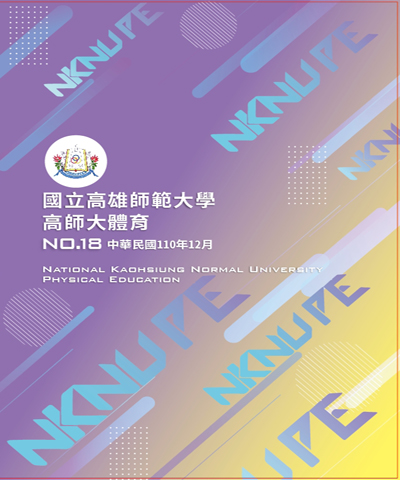
高師大體育
高雄師範大學,正常發行
選擇卷期
- 期刊
體育教師是體育課上課教學氣氛營造的最大關鍵者,體育教師的教學指導策略之決定,例如:課程實施的教學方式、課程目標、學生如何分組,或如何獎勵以及評量學生方式,皆會影響學生在體育課中對於身體活動的動機水準知覺。本文主要描述在TARGET理論架構下,有關體育教師對於教學環境之營造。
- 期刊
本文在於介紹執行者與教練獎賞制(Performer and Coach Earn Rewards, 簡稱PACER)之體育教學策略概念,提供國內各級體育教師課程設計之參考,PACER教學策略是一種可考量作為取代傳統教學的體育教學替代方案,以符合各級學校不同學生的身體活動需求,並提高學生對於體育課的合作情操及動機。
- 期刊
Purposes: This study examines the used tennis drills for won or lost points during games of four male elite tennis players who attended 2010 U.S. Open tournament semi-final games. In order to understand current professional male elite tennis players the tennis drills they used and their play strategies developed. The results will provide some suggestions for designing tennis training programs。Methods: The recorded video films analyses and record sheets were used for study purposes. Data were analyzed the 2010 U.S. Open tournament male single semi-final games(Novak Djokovic vs. Roger Federer; Rafael Nadal vs. Mikhail Youzhny). The used tennis drills were classified into baseline stroke, return, pass, chop, drop, lob, approach, volley, smash, first serve, and second serve. The Chi-Square Test statistical methods were used for data analyses. Results: There were significant differences among four male elite tennis players for the lost points used drills, and there were significant differences (x^2=83.63, p <.05) among four male elite tennis players for the won points used drills which they performed during games (x^2=59.35, p<.05). The advantage won tennis drills they used individually as followed: For Federer were baseline strokes(27.9%) and first serves(25.2 %); For Djokovic baseline strokes won rate (49.4%) was higher than the other tennis players. Nadal also were baseline strokes(37.2%) and first serves(24.5%); The same, the baseline strokes also were the most won point drill for Youzhny. The return drill won point rate for Djokovic(59.3%) and approach drills won point rate for Federer (50%) were higher than the other tennis players individually. Conclusions: For current elite male tennis players, the baseline strokes and serve drills were their major won point tennis drills. Especially, the baseline drills were the most important key tennis skill for winning point than serves during games. During tennis training sessions, coaches and players need to emphasize the accuracy and variety of serve and baseline drill practices to enhance their tennis skill levels completely.
- 期刊
The purpose of this study was to explore the learning effects of junior high students' perceptions of personal and social responsibility among three different teaching styles in teaching billiard units. This survey included totally 95 beginners, who were selected from the first-grade students of Kaohsiung Municipal Fong Ling Junior High School and who did not have any learning experience of billiards. These students were divided into three study groups according to the classes they belong to: (i) the command teaching group, reciprocal teaching group and sport education model group. The experiment had been undergone for 12 periods during 6 weeks, including a pre-teaching and a post-teaching survey with questionnaire based on respondents TPSR model. Statistical analyses based on obtained data were concluded as followed:There were significant differences of scores of post-teaching TPSR model among the three different teaching styles (command style, reciprocal style and sport education model style) (caring for others, F=5.56, p < .05; self-directed, F=6.32, p < .05; personal responsibility, F=4.72, p < .05;TPSR model, F=4.90, p < .05)。 Using Scheffé post hoc comparison method the results showed that reciprocal style and sport education model style groups had the higher post-teaching scores in caring for other, personal responsibility, and self-directed subscales than command style group, respectively. reciprocal style group had the higher post-teaching scores in TPSR model than command style. Conclusions: different physical education teaching styles may influence the students' perceptions of personal and social responsibility model.
- 期刊
本研究目的在以系統觀察法分析國中跆拳道教練的訓練指導行為,經由將訓練過程以錄影方式紀錄,進而探討教練、選手對教練本身訓練行為的看法,以及其間的一致性。研究對象為一位國中跆拳道專任教練及其訓練的19名選手,研究方法採用亞歷桑那州立大學觀察工具(Arizona State University Observation Instrument,ASUOI)加以分析歸類,並觀察影帶中的教練行為,對照逐字稿所顯示的口語記錄,逐一依類目定義編碼於事件記錄表內。採用事件記錄法,就次數、總數、百分比及問卷,依得分的多寡來瞭解教練的訓練指導行為,共計 80分鐘的訓練過程,出現244次的行為類目。歸納其出現最多的行為依序為,管理、當場指導、正面示範,出現最少者,則為無法編碼、發問、事後指導等。經由結果的分析與討論,獲致結論如下:一、參與本研究的國中跆拳道個案教練之訓練行為分配情形:1、本研究中非指導類行為高於指導類行為,指導類行為佔47.1% ,其中,又以當場指導類為最高,而非指導類行為,則佔52.9%。2、在所有指導行為中,以當場指導出現比率為最高,正面與負面示範行為比率為4:1,讚美與責備行為比率是3:1。二、教練、選手知覺及觀察到教練訓練行為間的一致性方面:1、觀察行為與教練知覺、選手知覺三者間一致性較高者,以催促、正面示範、肢體協助是三者所共同認同之教練訓練行為。2、觀察行為與教練、選手知覺三者間的不一致現象,得知本研究的教練只能部份正確評估其行為。3、就不一致的現象而言,教練在實施訓練時有必要,使選手對訓練行為能具有更清楚明白的知覺,以為選手營造一個正面而有效的訓練環境。建議如下:跆拳道教練為能有效進行訓練,應透過適當的肢體輔助、正確動作示範、即時催促等行為,經由指導來促進運動技能之學習,且以讚美行為來培養選手學習動機及鼓勵選手參與訓練,以期增進選手訓練的成效。
- 期刊
自閉症學生因為本身徵狀的影響,常限制了他們身體活動的正常發展,可能成為身體活動不足的高危險群,尤其是在青少年階段。本文主要目的在於簡介自閉症學生之徵狀及其學習特質,並將其體育課程設計原則融入籃球與體適能教學中,希望能提供體育教師及身體活動相關從業人員教學或研究時的參考。
- 期刊
規律身體活動可促進身體健康與提升生活品質;對於孩童與青少年,規律的身體活動更可增加骨質健康及身體適能等,也可減少體脂肪與降低心理壓力(U. S. Department of Health and Human Services (USDHHS), 2011)。在身心障礙保護法、特殊教育法公佈之後,臺灣的身心障礙族群已逐漸受到重視,然而,一般人在觀念上容易認為運動對於身心障礙族群是危險的、不必要的、且是附屬的(林鎮坤,2003),如此一來便間接剝奪了身心障礙族群的運動權。因此,如何適其所需,設計完善的適應體育教學,是體育老師或相關從業者都須思考的問題。本文主要目的在於簡介適應體育的教學原則,將之融入自閉症者(星星兒)之游泳課程,並分享實務經驗提供給體育教師及相關從業者教學或研究時的參考。

